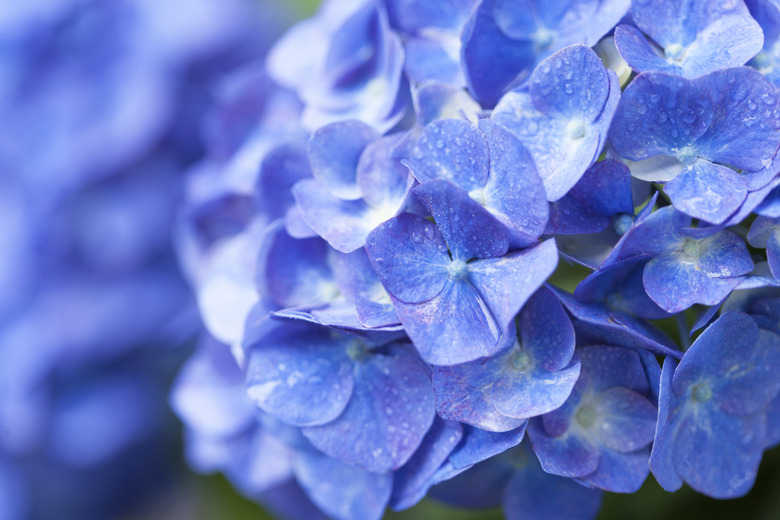How To Keep Hydrangeas Pink Or Blue
Pink or blue is not a question reserved strictly for baby clothes. One of the many allures of bigleaf hydrangea (Hydrangea macrophylla) is that you can alter the hue of their pom-pom blossoms from sky-blue to violet to sunset pink. The procedure has nothing to do with the plant's sex, but it does involve a "dirty" secret.
Step 1
Of the 23 species of hydrangea in the world, bigleaf is Miss Popularity in the United States, thriving in U.S. Department of Agriculture plant hardiness zones 5 through 9. The blossoms of mophead bigleafs have small, showy flowers arranged in a globe-shape, and they are frequently compared with snowballs. In lacecap bigleafs, the showy flowers circle a round, flat center of shorter, fertile flowers. These shrubs can get as tall as the gardener planting them, and spread to 4 feet wide.
The Dirt on Color-Change
Step 1
Soil is all, when it comes to bigleaf blossom color. The flower color comes from plant cell pigments called anthocyanins that look blue when packed densely, pink when few and far between. A hydrangea absorbing significant aluminum from the soil packs anthocyanin molecules closer in its cells which turns its flowers blue. Since hydrangea absorb aluminum more readily in acidic soils, bigleafs growing in highly acidic soils turn deep blue. In less acidic soil, the hues move toward pink. Since your hydrangea color depends on soil acidity, knowing how to measure it is important.
Step 2
- Of the 23 species of hydrangea in the world, bigleaf is Miss Popularity in the United States, thriving in U.S. Department of Agriculture plant hardiness zones 5 through 9.
- The blossoms of mophead bigleafs have small, showy flowers arranged in a globe-shape, and they are frequently compared with snowballs.
Testing Soil Acidity
Step 1
You don't need a PhD to understand soil acidity, but you do need to be clear on pH. The units used to measure soil acidity are termed pH units, with the pH scale running from 0 to 14. The lower the pH, the higher the acidity. Test your soil's pH with a simple home kit with test strips or send a soil sample to a laboratory recommended by your garden store. In either case, gather a representative soil sample by taking several slender slices of soil down to about 10 inches in different parts of the hydrangea bed. Mix the slices in a clean bucket then use a sample from the bucket for the test.
Color Coding
Step 1
With your soil pH test results in hand, you can consider preserving your bigleaf color. If your soil pH is 5.5 or lower, your shrub will grow blue flowers. Pink flowers are the norm with a soil pH of 6.5 or higher. A hydrangea growing in the no-man's-land between 5.5 and 6.5 produces violet flowers or a hop-scotch of blue and pink. If your current flower color lines up with your soil pH, you do not need to take any action at all. If your recently-planted bigleaf color does not line up with the test results but is within one pH level, you can amend your soil to preserve the current color.
Step 2
- You don't need a PhD to understand soil acidity, but you do need to be clear on pH.
- The units used to measure soil acidity are termed pH units, with the pH scale running from 0 to 14.
- If your recently-planted bigleaf color does not line up with the test results but is within one pH level, you can amend your soil to preserve the current color.
Changing Acidity
Step 1
To increase the acidity of the soil and lower the pH by one point, broadcast 1/2 cup of wettable sulfur per 10 square feet of soil, taking care not to get any on the plant leaves. To decrease the acidity of the soil and increase the soil pH, apply dolomitic limestone in the same manner. The amount of lime to add depends on the type of soil you have and the type of lime product you use, but you'll need about 1 cup per 10 square feet. Water the sulfur or lime into the soil. If your soil is more than one pH level from the level you need, plant your hydrangea in a container or a raised bed where you can control the soil acidity more easily.
References
- Clemson Cooperative University: Hydrangea
- Fine Gardening: Big Flowers from Bigleaf Hydrangeas
- Fine Gardening: Some Flowers Can Change Color
- Fine Gardening: Four Things You Need to Know About Soil pH
- Clemson University Cooperative Extension: Changing the pH of Your Soil
- University of California: Changing the pH in Soil
- Auburn University: Hydrangeas
